Your lawn, which was green, full and healthy, seems to be in bad shape. Yellow patches are appearing in various places or are even completely covered… why? and what to do?
In fact, there are several causes for this yellowing. The first step to take when you notice the appearance of yellow patches on your lawn is to contact your Nutrite Expert to identify the source of the problem so that you can provide the right treatment.
Why is my lawn yellowing in places?
The most common causes of yellowing lawns are: diseases, insect infestations, environmental conditions and poor maintenance techniques. While yellowing of the lawn can be alarming, “yellow grass” does not necessarily mean “dead grass”, it can be dormancy. Dormancy is a protective system that ensures the survival of the lawn when it is under great stress, for example, a drought. You can save your lawn with the right treatments.
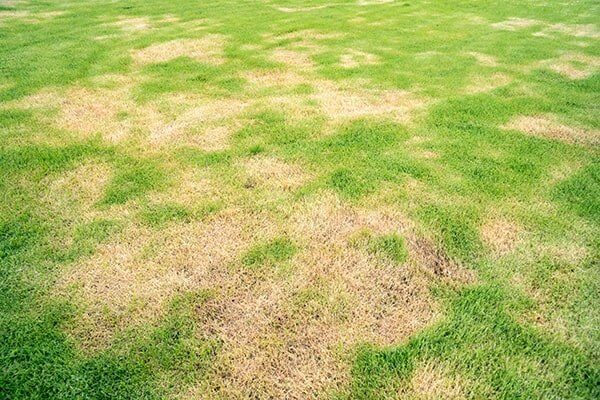
Diseases that cause yellowing of the lawn
In Quebec, there are no registered products to treat fungal diseases on residential lawns. Proper care of your lawn will ensure a healthy lawn.
Dollar spot
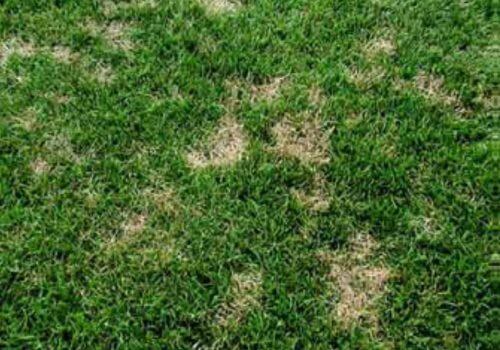
Signs
Small yellow or orange patches about the size of a dollar coin form on the lawn. White mycelium, which looks like a spider web, can also be seen on the lawn in the early morning.
Solutions :
- Sharpen the mower blade and choose a mowing height of 3 inches.
- Where regulations permit, water in the morning (between 5:00 a.m. and 8:00 a.m.) rather than in the evening and at night.
- Remove grass clippings to prevent the spread of disease.
- Perform aeration.
- Fertilize the lawn with a nitrogen-rich fertilizer.
Red thread
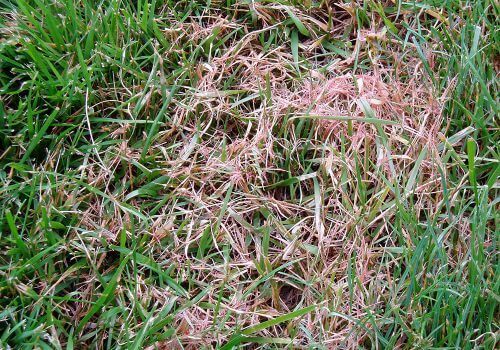
Signs
Small red or pink filaments appear on the top of the lawn as the nights begin to cool. This is a disease that attacks grass that has been damaged by the blade of your mower and shaded areas that remain wet for too long.
Solutions :
- Sharpen the mower blade and choose a mowing height of 3 inches.
- Where regulations permit, water in the morning (between 5:00 a.m. and 8:00 a.m.) rather than in the evening and at night.
- Remove grass clippings to prevent the spread of disease.
- Perform aeration.
- Fertilize the lawn.
Leaf blight

Signs
This disease attacks the foliage, crown and roots of the grass and gives it a yellow color. You can see small yellowed and dry paths caused by this disease in early spring.
Solutions :
- Sharpen the mower blade and choose a mowing height of 3 inches.
- Where regulations permit, water in the morning (between 5:00 a.m. and 8:00 a.m.) rather than in the evening and at night.
- Ensure good drainage, the lawn must dry.
- Remove grass clippings to prevent the spread of disease.
- Limit the thickness of thatch.
- Fertilize the lawn.
Spring lawn disease or snow mold
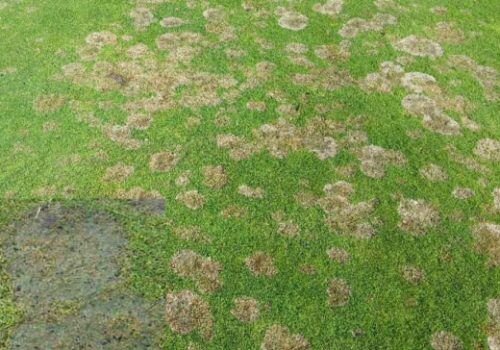
Signs
If your lawn turns yellow after winter, it may be a victim of snow mold caused by excess moisture from melting snow. It can be recognized by the beige circles, more or less large, that it leaves on the lawn before it turns green.
Solutions :
- Rake the lawn.
- Avoid watering the lawn.
- Fertilize the lawn with a potassium-rich fertilizer in the fall.
- Make the last mowing of the year at 5 cm.
- Perform aeration.
Pests causing yellow lawn spots
Various insects can attack your lawn and cause varying degrees of damage very quickly. Be attentive to the slightest changes in your lawn so that you can intervene before the damage is very serious, even irreversible.
Need help identifying the insect that is causing you all these headaches? Contact a Nutrite Expert without delay.
Chinch bugs
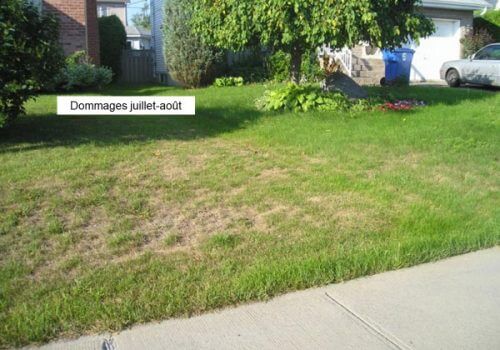
Signs
Also known as chinch bugs and lawn fleas, hairy chinch bugs will appear around mid-July. Be especially vigilant when temperatures are hot and dry, as this is when they are likely to appear and cause the most damage. You will notice their presence quickly as they form large yellow, dry patches of grass that will grow steadily until they clear entire sections. Not to be confused with drought.
Solutions :
- Call a Nutrite Expert to treat your lawn for insects quickly.
- Apply insecticidal soap to affected areas.
Sod webworm
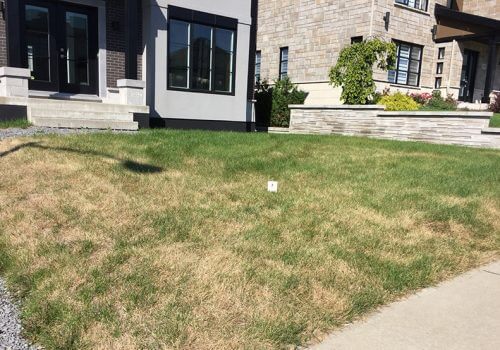
Signs
The sod webworm is an insect that causes irregular patches of yellow grass ranging from a few centimeters to several meters in diameter. The grass will easily tear away if you pull on it in these areas. The larvae of the sod webworm could damage your lawn until the first frost in the fall if left uncontrolled.
Solutions :
- Apply a control product in the fall when damage first appears.
- Rake affected areas of lawn, then overseed.
- Aerate in the spring, then over-seed and fertilize affected areas of lawn.
- Where regulations permit, water thoroughly in the evening or morning.
- Treat with a preventive control product in the spring.
White grubs
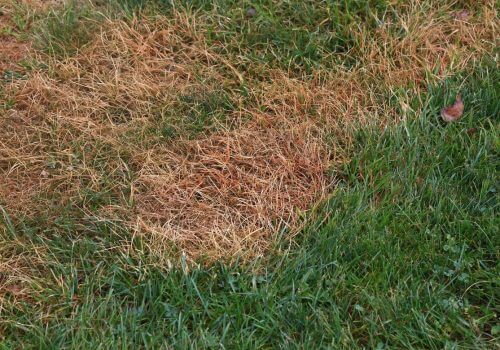
Signs
Grubs cause irregular patches of yellow grass that can grow up to a meter or more in diameter. Your lawn may also be ravaged by skunks looking to feed on these grubs. Because the grubs eat the roots, the grass will no longer have a grip on the soil and will easily pull away when you pull on it.
Solutions :
To control the infestation in the spring and fall:
- Remove dead patches of grass or infested areas.
- Add quality soil and reseed or replant the lawn.
- Turn off the lights that attract the adults when they emerge in June and July.
- Contact your Nutrite Expert for a white worm preventive treatment.
- Apply an over-the-counter insecticide to destroy the larvae.
Other pests

Signs
Some less common insect species such as cutworms, marsh crane flies and bluegrass hornworms can also harm your lawn and cause yellow patch.
Solutions :
- If you don’t know what kind of insect is abusing your lawn, contact a Nutrite Expert and he or she will give you the right diagnosis and solutions to control the damage and repair the lawn.
Environmental conditions causing yellow lawn patches
Sometimes it is environmental causes that cause yellow patches. The first thing to do to establish the right game plan is to identify what is creating the problem. Remember that grass is a plant and is subject to the vagaries of Mother Nature.
Cold damages
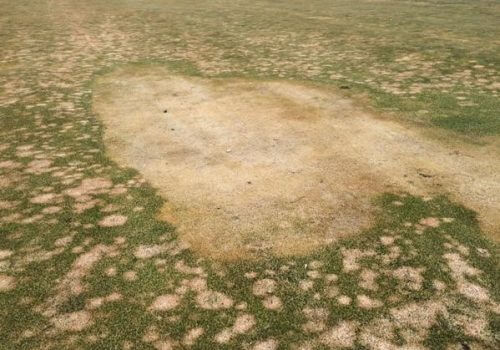
Signs
If large patches of grass don’t green up in the spring, it may be because they froze. The snow cover was not thick enough to protect your lawn from the cold.
Solutions :
- Rake affected areas of lawn, then overseed.
- Fertilize the lawn.
Severe or prolonged drought
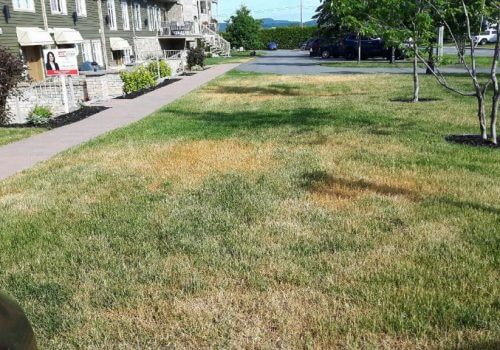
Signs
The grass turns uniformly yellow and becomes very dry. It is important to know that the grass is not dead, but dormant, meaning that it stores all its energy in its roots to protect itself from the sun. As soon as the rain or cool weather returns, the grass will green up.
Solutions :
- Stop mowing the lawn.
- Avoid trampling the lawn.
- Try to water the lawn at least once a week in the early morning (within watering restrictions).
Inadequate lawn care and other reasons responsible for yellow lawn
Lawn care and the impact of humans and pets can also play a role in yellowing. Again, the right diagnosis will allow you to correct the situation to avoid further damage.
Lack of fertilizer
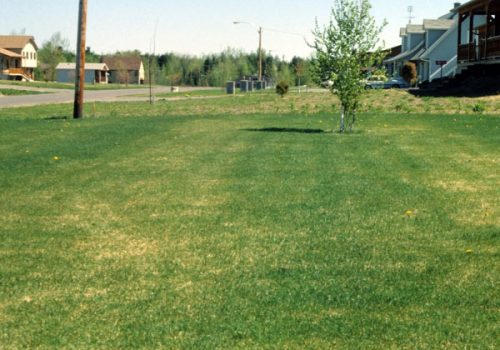
Signs
A yellow lawn after winter with little or no greening can be caused by a lack of nutrients in the soil.
Solutions :
- Fertilize the lawn.
- Aerate the lawn.
- Apply lime.
Over-fertilization
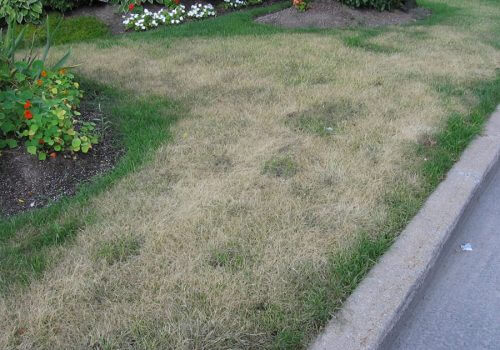
Signs
After a fertilization, your lawn becomes yellow and dry, as if it had been burned by the fertilizer. This can happen if you don’t follow the manufacturer’s instructions or if you fertilize during a very dry period.
Solutions :
- Water thoroughly (respecting watering restrictions).
- Avoid trampling the lawn.
- If the grass does not grow back, reseed or replant with sod.
Dog urine
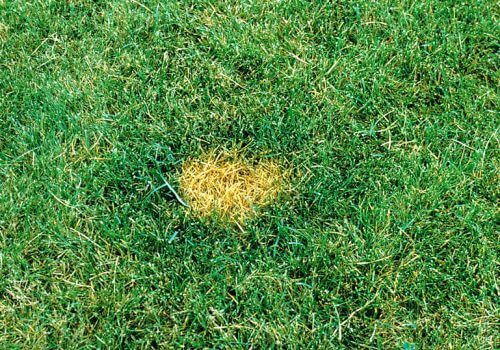
Signs
Urine causes yellow grass patches with a dark green outline because it is highly concentrated in ammonia.
Solutions :
- Dilute the urine by pouring water over the area where your pet is relieving itself.
- Get your dog used to doing his business elsewhere.
Other stress factors
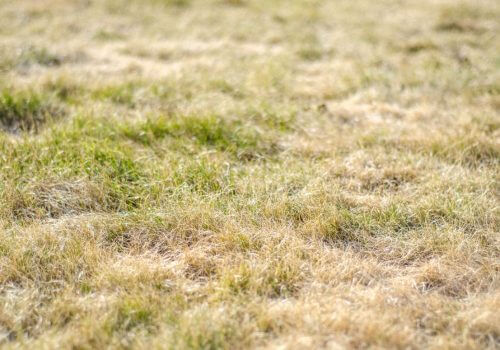
Signs
As a plant, many stressors can cause your lawn to turn yellow, such as: campfires, chemicals, items left in place too long, repeated visits to the same spot, etc.
Solutions :
- Fertilize the lawn.
- Aerate the lawn.
- Apply lime.
How to save a yellowed lawn?
The treatment of your lawn will depend on the cause of the problem. Generally, with proper mowing and watering, you should be able to get rid of the yellow patches. However, if you do these steps well, but yellow patches persist on your lawn, your options are:
- Lawn fertilization.
- Insect control (treatments applied by experts).
- Aeration of your lawn.
- Seeding (overseeding).
- Application of lime for lawns.
Contact a Nutrite Expert, he will help you find the cause of your yellow patch problem and suggest the right combination of treatments to solve it.

